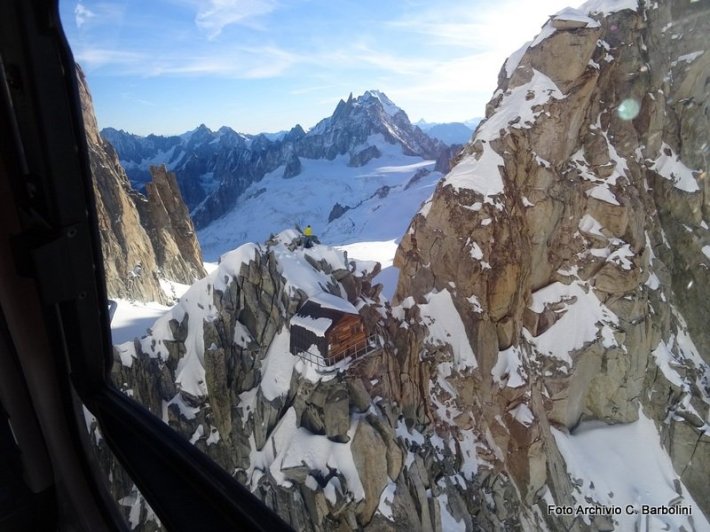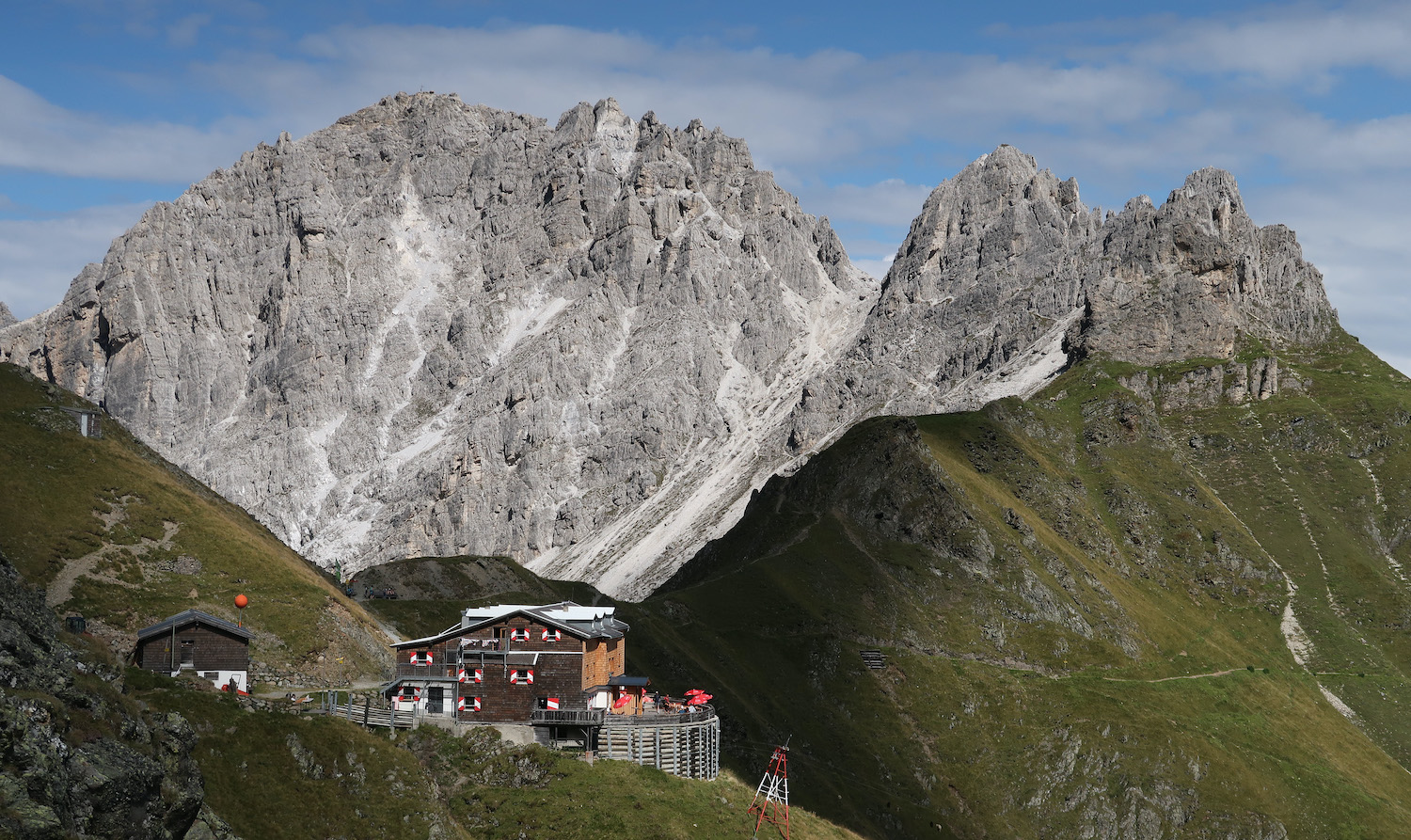The Bivacco Alberico, otherwise known as the Bivouac de la Fourche, was a beautiful wooden cabin built near the summit of Mont Maudit in 1935 to house mountaineers on their way to the summits of Maudit and Mont Blanc. The cabin was perched on the angry, vertiginous edge of the mountain ridge, a little nest that could fit to 15 people in one of the most inaccessible parts of Europe, a monument in tribute to and in defiance of the rugged serenity of the Alps. It's gone now. On August 25, a rockslide sent the entire cabin crashing to the Brenva Glacier below, where it will rest forever. Nobody was hurt in the collapse, as the hut had been rendered inaccessible by the conditions that caused the landslide: a lack of glacial ice gluing the rocks together. The Club Alpino Accademico Italiano, who first announced the news, wrote, "The mountain of the future will be different from the one we have known until now."

The Alps as we know them are being dramatically reshaped by Europe's ongoing, epochal drought, a protracted state of arid conditions so dire that the receding waters are peeling back layers of history as they vaporize. Sunken Nazi warships have poked up from the streambed of the Danube, an ancient megalithic monument has emerged from a quarter-full reservoir in Spain, and a famously stupid bridge built by the moronic Roman emperor Nero is now fully visible instead of buried under the Tiber. The European Commission estimated this may be the continent's most significant drought in 500 years, an outlandish figure that feels less abstract for all the history it's revealing; it will certainly not be the worst drought of the next 500 years.
Those rivers will fill up again, probably past capacity at some point, though the dramatic melting of Alpine glaciers currently underway will be permanent. Temperatures in the Alps have increased at roughly twice the global average. The stage was set for this summer's spate of disasters last winter, when it barely snowed. Though the cause of both the scant snowfall and rapid melting is the same (global warming), neither condition is unprecedented. What's different, at least in degree, is the brutal one-two, where a bad snow season was followed up by an infernal summer. The loss of Bivacco Alberico is but one of the many seismic (in some cases, literally) events that's shaken the Alps this infernal summer.
On July 3, 11 people were killed and eight people were wounded while mountaineering on the Dolomitic peak Marmolada after a serac—essentially a wall-shaped mass of glacial ice—broke off and caused an avalanche. Temperatures on the summit of Marmolada were higher than 50°F, causing a chunk of ice that a team of French scientists later estimated was 80 meters by 25 meters to detach from the glacier and tumble down the mountain. Italy's then-prime minister, Mario Draghi, made explicit the link between the disaster and climate change. Marmolada was the most notorious incident this summer, though many others have died and the number of people requiring rescue has ballooned, straining the capacity of aid workers.
Following the Marmolada disaster, guides stopped offering tours of iconic Alpine peaks like Mont Blanc and the Matterhorn. The mayor of Saint Gervais, a French town that is the de facto gateway to Mont Blanc, closed down the extremely popular Tête Rousse and Goûter refuges after would-be mountaineers kept trying to conquer the mountain despite the obvious danger of doing so. He was so mad that he announced that he would seek a €15,000 deposit from "irresponsible fools" determined to "seek death in the form of suicide" by climbing Mont Blanc.
#Rockfalls in Goûter couloir on #MontBlanc normal route two days ago due to anomalously high temp. this summer.#Goûter and Tête Rousse mountain huts are now closed (!) since yesterday to stop use of the area...
— Melaine Le Roy (@subfossilguy) August 6, 2022
Video credit @RedactionRMB pic.twitter.com/Trw69V4Tbz
There is no reversing what's happening to the Alps. They will not rebuild Bivacco Alberico, as there will soon be no more glacial ice to build it on. I think the role of glaciers can best be understood as space's check on Earth's ambitions. The dynamic of every mountain range is a cosmic contest between uplift and erosion, two opposing forces pulling and pushing millions of cubic meters of rock up from the inner Earth or back down to its surface. Eventually, erosion always wins. Every uplifting eventually stops, but the Earth never stops moving, sanding down even the highest peaks with rain, wind, and ice. At the highest elevations on Earth, erosion works on a different scale than any of its colleagues. While rain leaves nice, V-shaped river valleys, an oozing glacier pushing its weight down on the Earth will scoop out U-shaped gouges of land, leaving behind great gaps of air, like Yosemite Valley. Any mountain range that peeks its peaks too far towards the upper layer of the atmosphere will eventually be ruthlessly buzzsawed down.
That dynamic still holds under global warming, though the point at which snow falls in significant enough amounts to unionize itself into a glacier rises. Every one-degree (Celsius) increase in temperature has a corresponding 150-meter increase in the elevation of the snow line. The point of glaciation is higher still than that, and if you repeat this dismal process long enough, eventually you run out of glaciers. The continental United States' glaciers are melting faster than ever before. Indonesia's last glacial holdouts are dying rapidly. Presumably you know what's going on in Greenland. Alpine glaciers are marvelous organs, evidence of the Earth's unwitting capacity to regulate itself. They are not supposed to move on human timescales, but they also do not move on geologic timescales. They are supposed to be a ligament between our person-sized perception of time and the impossibility of holding the concept of, like, one billion years in your head. Climbing around on a glacier seems like a powerful, scary way to commune with that dissonance, and I don't know how much longer that will be possible in Europe.






